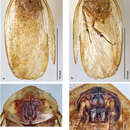Description
provided by Zookeys
Male. Measurements. Holotype TL = 19.7 mm, GW = 9.5 mm, PW = 5.37 mm, PL = 3.98 mm, TL/GW = 2.07, PL/PW = 0.74. EW = 0.15 mm; OW = 0.40 mm.
Head. Two ocelli large, ovoid and protruding (0.40 × 0.25 mm); vertex dark brown, with small ridges between apices of eyes and extending onto ocellar tubercles; interocellar space concave, dark brown. Frons dark medium brown; posterior concave; anterior portion of frons bulbous but much less so than in most species, dark medium brown; light brown anteclypeus. See Fig. 57d.
Pronotum. Pronotum translucent waxy light brown; dorsal surface of pronotum with dense orange-brown setae that are longer and thicker laterally; pronotal pattern dark orange-brown “panther face”, impressed; slight aura. See Fig. 57c.
Body. Wing brace absent. Two tarsal claws present. Legs and body medium brown; subgenital plate orange-brown; strongly asymmetrical with posterior edge only slightly emarginated and rounded apices. See Fig. 57b.
Forewings. Wings extended beyond abdominal apex; light brown with sparse medium brown blotches; surface translucent with mild sheen. See Fig. 57a.
Genitalia. Right dorsal phallomere composed of lightly sclerotized, narrow, bulbous lobe, articulated with right ventral phallomere on lateral side; central field lightly sclerotized, cupped; with narrow medial edge more sclerotized, punctate, ending anteriorly in small shagreened flange. Small central sclerite lightly sclerotized, finely punctate, concave with two punctate lobes wrapping anteriorly around shagreened flange of right dorsal phallomere, posterior end connecting with dorsal side of right dorsal phallomere. Articulation between right phallomeres deep, concave and setose, with shagreened border adjacent to dorsal phallomere and smooth border adjacent to ventral phallomere. Right ventral phallomere consists of large punctate flattened medially projecting lobe; becoming wider and more sclerotized anteriorly; anteriorly narrow gap followed by wide shagreened flange. Folded anterior portion of left phallomere wide, setose, otherwise unmodified. Genital hook widely curved to sharp point; arm robust and straight. See Fig. 58.
- bibliographic citation
- Hopkins H (2014) A revision of the genus Arenivaga (Rehn) (Blattodea, Corydiidae), with descriptions of new species and key to the males of the genus ZooKeys 384: 1–256
- author
- Heidi Hopkins
Distribution
provided by Zookeys
This species is known only from the type locality. See Fig. 59.
- bibliographic citation
- Hopkins H (2014) A revision of the genus Arenivaga (Rehn) (Blattodea, Corydiidae), with descriptions of new species and key to the males of the genus ZooKeys 384: 1–256
- author
- Heidi Hopkins

